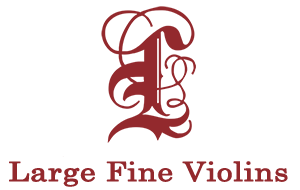|

|
Eugène Nicolas Sartory (1871-1946) was born in Mirecourt, France, and first learned his bowmaking from his father. He then travelled to Paris to take on apprenticeships in many workshops, including Charles Peccatte′s and Alfred Lamy′s, whom Sartory was most influenced by. Sartory went on to win the gold medal at a competition in Brussels at a very young age of 16.
Following his early success, Sartory was permitted to produce his own style of bows and although his early works show significant similarities to that of Lamy′s - with higher back of head, sensitivity and elegance - Sartory′s later works are evident of his individual style characterised by higher, broader and stronger head. Furthermore, by moving the shaft cross-section closer to the tip and thickening the shaft above the handle, he was able to realise more stability and reliability while playing. Sartory′s bows are very well balanced throughout the shaft mainly due to his unique style of putting the finishing touches by playing with the bow himself. Once a bow has been made, he would ʻtest driveʼ the bow and would do minor alterations to maximise its balance and playing quality. Therefore, reworkings on the shaft can be seen under the black light in most of his works even in its original condition. All these aspects greatly influence the bows′ functionality, which was said to be better than that of Tourte′s and Peccatte′s. Sartory was most probably a fine string player as well.
Another distinctive characteristic of Sartory′s bows from a restorer′s point of view is that repairs and rehair on his bows are drastically simpler than the other bows. For example, because the mortise is very well shaped on his bows, the wedges are far easier to make, fit and remove, and it makes it easier to evenly spread the hair. Also, his own style, mechanics and innovation make it easier to maintain his bows in good condition. This clearly shows that he was concerned not only about its functionality, but also about rehairing and maintaining of the bow. It can then be said that he made his bows wanting to satisfy both players and repairers over generations to come.
Sartory won awards in six competitions and his bows were very much admired and sought after that many Sartory copies were made from the early years. It is said that when he was in the States and was asked to rehair a bow, which happened to be a copy of his, he snapped it in half and instead returned his original bow.
Throughout his life, he continued to work hard and regularly produced bows that were respected and popular among the players, collectors, investors and dealers.
This "ex-Capet" was made by Sartory for a french violinist Lucien Capet. Capet was a master of high level bow technique, and wrote a treatise "La Technique supérieure de l'archet où abondent les exemples et les détails" which covers all aspects of bowings. He ordered bow makers, not only Sartory, but also Vigneron, Ramy, Fetique, to make bows in his style. Capet style bows are usually slightly heavy, and had the lower centre of gravity for stability.
Capet founded his own quartet in 1893, but was also a second violinist in Geloso Quartet; its 1st violinist, Geloso, played with the bow especially made for him by Rammy, which we will introduce next.
| |

โ View large images
| | | | | | |  Lucien Louis Capet Violinist (1873-1928) Lucien Louis Capet Violinist (1873-1928)

Capet came from the Paris proletariat. By the age of fifteen, he had to maintain himself by playing in bistros and cafes. He studied at the Conservatoire de Paris where he was a pupil of Jean-Pierre Maurin and later appeared as soloist with French orchestras. Between 1896 - 1899 he was the concertmaster of l'Orchestre des Concerts Lamoureux. He also taught violin at the Société Sainte-Cécile de Bordeaux (1899-1903). His notable students include Jascha Brodsky and Ivan Galamian, both of whom became influential violin teachers of the latter part of the Twentieth Century.
Jascha Brodsky's students include: Hilary Hahn, Joseph de Pasquale, Leila Josefowicz, Joey Corpus, Juliette Kang, Judith Ingolfsson, Herbert Greenberg and Chin Kim.
Ivan Galamian's students include Sally Thomas (who became his assistant), Michael Rabin, Itzhak Perlman, Pinchas Zukerman, Isidor Lateiner, Kyung-wha Chung, Glenn Dicterow, David Nadien, Erick Friedman, Jaime Laredo, Arnold Steinhardt, Charles Castleman, Miriam Fried, James Buswell, Sergiu Luca, Charles Treger, Ani and Ida Kavafian, Kaoru Kakudo, Ray Dotoratos, Chin Kim, Eugene Fodor, Daniel Phillips, Berl Senofsky, Betty Jean Hagen, Young Uck Kim, Stuart Canin, Eugene Sarbu, Dong-Suk Kang, Gregory Fulkerson, Simon Standage, and Kate Stenberg of Del Sol Quartet.
Lucien Capet had a successful career as a soloist and chamber musician, forming the Capet Quartet in 1893. The quartet went through many changes of personnel and made several recordings of Beethoven string quartets and Romantic and Classical works. Capet was also a well-regarded teacher, known especially for his bow technique.
With the violinist and chamber musician Suzanne Chaigneau, Capet founded the Institut moderne du violin in 1924.
Capet wrote a book on "Superior Bowing Technique" which is an essential treatise on all aspects of bowing technique for the violin; reprints are available (including translations into English by Margaret Schmidt and Stephen Shipps).
| | | | | | | |
| |
|

|
|
|

